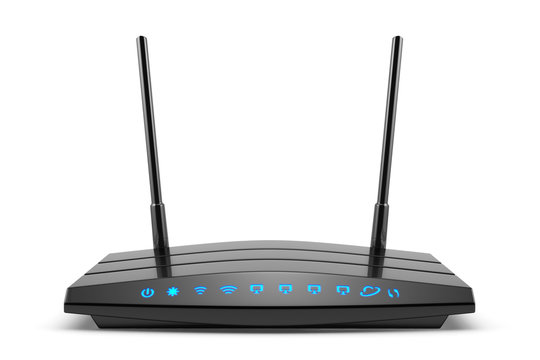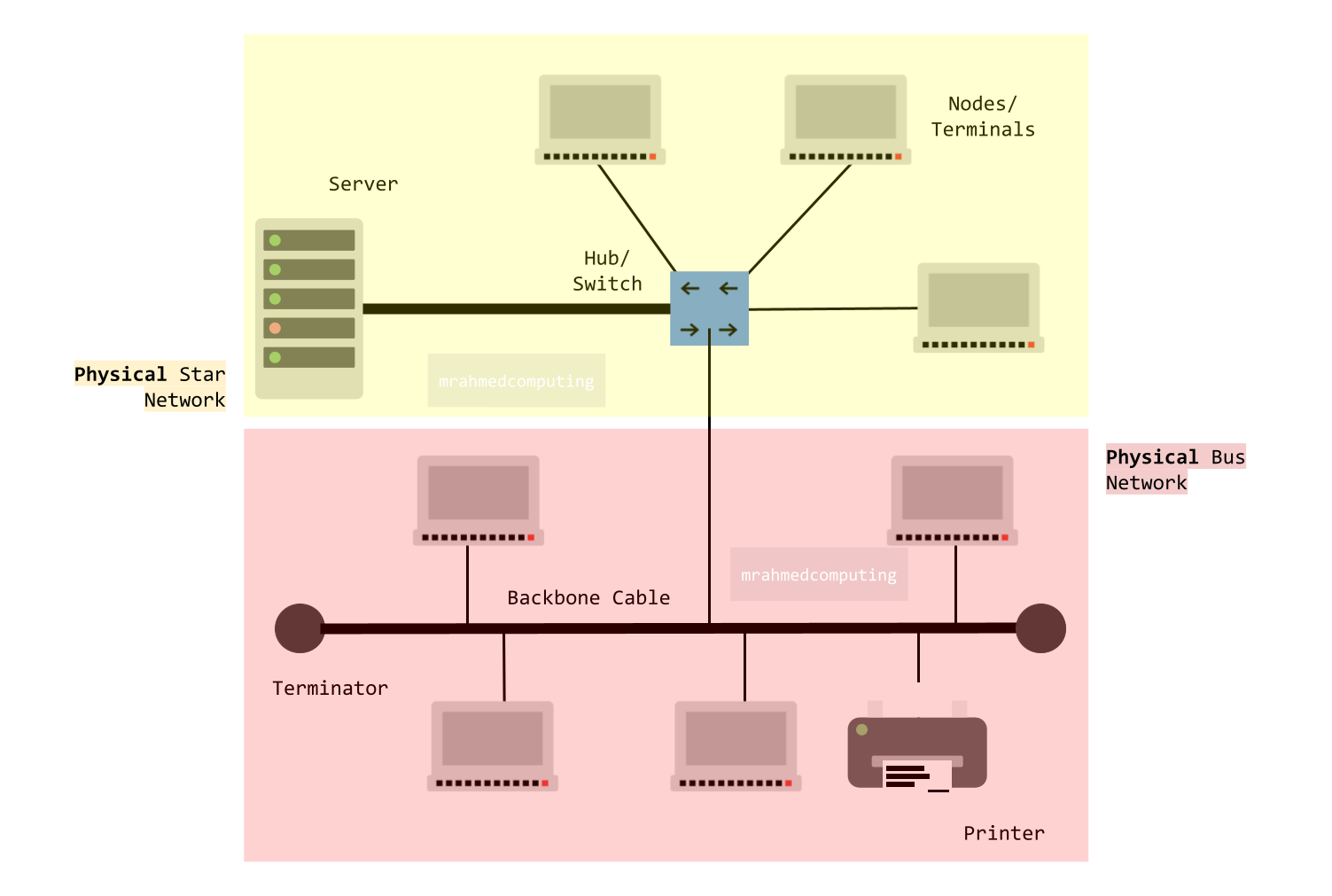Lesson 2. Network Topologies and Hardware
Lesson Objective
- Understand the use of MAC addresses.
- Explain the use and function of some networking hardwares.
- Identify advantages and disadvantages of bus and star networks.
- Understand physical network topology and logical bus network topology.
- Explain and describe situations where peer-to-peer networks and client-server networks are used.
Lesson Notes
MAC Addressing
A MAC address, which stands for Media Access Control Address, is a unique identifier assigned to a Network Interface Controller (NIC). MAC addresses help identify specific devices on a local network. They ensure that data gets sent to the correct device-for example, your computer rather than your roommate's smartphone. MAC addresses consist of a 12-digit hexadecimal number, with each pair of digits separated by a colon or hyphen.
3B:14:E6:39:0A:2C
The actual geographical location of a networked device can be determined by its IP address.

Network Interface Card
A Network Interface Card (NIC) is the hardware component that enables computers to communicate with other computers/devices within a network.
A NIC provides a dedicated connection between a computer and the network. It translates the computer's digital data into the signals used for data transfer within the network, whether via Ethernet or Wi-Fi.
Types of NICs:
- Wired NICs: These connect via Ethernet cables and are commonly integrated into motherboards.
- Wireless NICs (Wi-Fi): They use an antenna to transmit data to Wi-Fi routers using radio frequency signals.
Free image of a Network Interface Card:

Router
A router is a device that connects two or more packet-switched networks or subnetworks.
How does it work:
- A router forwards data packets between these networks, ensuring they reach their intended IP addresses. It acts as an air traffic controller, directing data packets efficiently to their destinations.
- To achieve this, routers use an internal routing table, which lists paths to various network destinations.
- When a packet arrives at the router, the router reads its header, determines the destination, and consults the routing table to find the optimal path. It then forwards the packet to the next network in the path.
Free image of a Router:

Comparing Routers and Modems
While some ISPs combine routers and modems, they serve distinct roles. Routers Manages data flow within and between networks. A Modem connects networks to the Internet by converting ISP signals into a digital format interpretable by devices.
A router allows multiple devices within a network to share the same Internet connection.
Switch
A network switch is a crucial piece of networking hardware that connects devices within a network, such as a local area network (LAN).
Unlike a router, which selects paths for data packets to cross networks, a switch focuses on interconnecting devices within the same network.
When a device sends data, the switch ensures it reaches the intended recipient (another switch, a router, or a user's computer), rather than broadcasting it to all devices.
Switches are essential for creating efficient and organized networks by managing data flow between connected devices.
Free image of a Switch:

Difference Between a Switch and a Router:
- Routers handle data forwarding between different networks (LANs, wide area networks, or the Internet).
- Switches, on the other hand, operate within a single network, connecting devices like computers, servers, and printers.
Wireless Access Point
A Wireless Access Point (WAP) is a networking device that allows Wi-Fi devices to connect to a wired network. These access points create wireless local area networks (WLANs), enabling seamless connectivity for portable devices.
It bridges the gap between wired networks (such as Ethernet) and wireless devices (like laptops, tablets, and smartphones).
Free image of a Wireless Access Point:

Server
A server is a computer that manages and stores files, or one that provides services to other computers on the network.
They control the network and allow other computers to share and communicate.
Typical servers include: file servers - hold and maintain user files.
Network Topologies
A LAN can be set up in different ways. Three of these topologies are:
Bus Network
In a bus network, all devices (such as computers, printers, and peripherals) connect to a main cable (the bus) directly. This shared cable acts as the communication channel for data transmission.
Advantages:
- It is easy to connect nodes to the network.
- Less cabling is needed compared to a star topology, making it cheaper to install.
Disadvantages:
- The whole network fails if the backbone cable is broken.
- Terminators must be installed at each end of the backbone.
- Having one backbone increases the chances of data collision.
Star Network
In a star network, all nodes indirectly connect to each other through a switch (or a hub). The switch acts as a central point through which all data can pass through.

Advantages:
- Fast data transfer as there are fewer data collisions - data goes from the switch to the workstation that requested it.
- If one cable fails the other workstations are not affected.
- New nodes can be added to the network simply by connecting them to the switch.
- Star networks tend to have higher performance as a message is passed on to its intended node only.
Disadvantages:
- Requires additional hardware such as the central hub or switch and lots of cabling - can be expensive.
- If the central device fails the whole network goes down.
Full Mesh Network
In a mesh topology there is no central connection point. In a full mesh topology, every node is connected. This allows data to be sent through many individual routes.

Partial Mesh Network
In a partial mesh topology, only some node are connected. There are fewer routes for data to travel along in a partial mesh. However, it is much simpler to implement.

Advantages:
- Data can be received more quickly if the route to the intended recipient is short.
- Data should always get through as they have many possible routes on which to travel.
- Each node can transmit to and receive from more than one node at the same time.
- New nodes can be added without interruption or interfering with other nodes.
Disadvantages:
- Full mesh networks can be difficult to implement because of the high number of connections needed.
- High maintenance (lots of connections).
Client Server Model
Appropriate situations for a client server network:
- On a network in which resources, security, administration and other functions are provided by dedicated servers.
- For networks with 10 or more computers.
- On large networks with a high volume of traffic.
Some security considerations:
- Servers are also responsible for security of files and folders - not the clients.
- Clients are usually less powerful than a server.
- Servers authenticate users when they log into a client, as the server stores all network logins.
- Back ups are central.
Here is a client server model that uses a Star Topology:

Examples of Server Based Networks: School Network, Web Servers, FTP servers.
Advantages:
- Security is better - Files are stored in a central location and access rights are managed by the server.
- Back ups are done centrally - No need for individual users to backup data. If a node stops working data is not lost.
- Data and resources can be shared.
Disadvantages:
- Expensive to install and manage.
- Professional staff needed to maintain and manage.
Peer to Peer Model
Appropriate situations for a Peer to Peer network:
- On a network where security is not an issue. Users are able to access shared resources without problem...
- For networks with fewer than 10 computers.
- For networks that are not likely to grow in the future.
Note: These reasons are specifically for local networks.
Some security considerations:
- Users are responsible for setting the security level for each PC.
- No central login, therefore there is no way of limiting resources to specific users.
- If a resource is not password protected then it is open to all PEERS on the network.
Advantages:
Disadvantages:
Here is a peer to peer network model that uses a Star Topology:

Here is a peer to peer network model that uses a Mesh Topology:

Physical and Logical Network
Physical Network?
Physical network structure. Physical wires (or Wi-fi) and connections and make up.
Logical Network?
How the data is transmitted. Even though it's physically set up as, for example, a star topology it can logically operate as a bus topology - by installing a bus transmission protocol (ethernet bus protocol)













